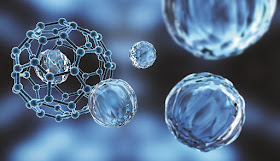Nanoparticles:
Nanotechnology produced materials of various types at the nanoscale level.
Nanoparticles (NPs) are a wide class of materials that include particulate substances, which have one dimension less than 100 nm at least.
Depending on the overall shape these materials can be 0D, 1D, 2D or 3D.
The importance of these materials realized when researchers found that size can influence the physicochemical properties of a substance e.g. the optical properties. A 20-nm gold (Au), platinum (Pt), silver (Ag), and palladium (Pd) NPs have characteristic wine red colour, yellowish-grey, black and dark black colours.
Nanorods - 50nm
Nanoshells - 140nm
Nanocages - 50nm
NPs are composed of three layers i.e. (a) The surface layer, which may be functionalized with a variety of small molecules, metal ions, surfactants and polymers.
(b) The shell layer, which is a chemically different material from the core in all aspects, and
(c) The core, which is essentially the central portion of the NP and usually refers to the NP itself
Owing to such exceptional characteristics, these materials got the immense interest of researchers in multidisciplinary fields.
Classification of Nanoparticles
NPs are broadly divided into various categories depending on their morphology, size and chemical properties.
Carbon-based NPs
Fullerenes and carbon nanotubes are two major classes of carbon-based NPs.
Fullerenes contain nanomaterial that is made of the globular hollow cage. CNTs are elongated, tubular structure, 1–2 nm in diameter.
The rolled sheets can be single, double or many walls and therefore they named as single-walled (SWNTs), double-walled (DWNTs) or multi-walled carbon nanotubes (MWNTs).
They are widely synthesized by deposition of carbon precursors especially the atomic carbons, vaporized from graphite by laser or by electric arc on to metal particles.
Lately, they have been synthesized via chemical vapour deposition (CVD) technique. Due to their unique physical, chemical and mechanical characteristics, these materials are not only used in pristine form but also in nanocomposites for many commercial applications such as fillers.
Metal NPs
Metal NPs are purely made of the metals precursors. These NPs possess unique optoelectrical properties. .Due to their advanced optical properties, metal NPs find applications in many research areas.
Ceramics NPs
Ceramics NPs are inorganic nonmetallic solids, synthesized via heat and successive cooling. They can be found in amorphous, polycrystalline, dense, porous or hollow forms.
Semiconductor NPs
Semiconductor materials possess properties between metals and nonmetals and therefore they found various applications in the literature due to this property.
Polymeric NPs
These are normally organic-based NPs and in the literature a special term polymer nanoparticle (PNP) collective used for it. They are mostly nanospheres or nanocapsules shaped.
Lipid-based NPs
These NPs contain lipid moieties and effectively used in many biomedical applications. Generally, a lipid NP is characteristically spherical with the diameter ranging from 10 to 1000 nm. Like polymeric NPs, lipid NPs possess a solid core made of lipid and a matrix contains soluble lipophilic molecules. Surfactants or emulsifiers stabilized the external core of these NPs .
BY,
DR.RENJU T GEORGE,
INDIA

No comments:
Post a Comment